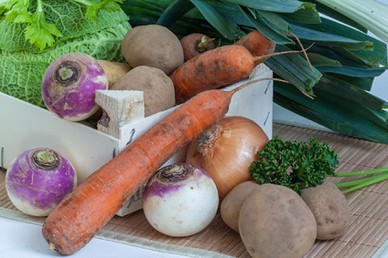Growers' Yearbook: October

October is a time to get the last of your crops in, it’s the time to start lighting your fires to ward off the chill, it’s time to start making stews on the fire and enjoying the fruits of your labour. If you have grapes you can harvest those to make lovely wine to warm your soul during the fast approaching winter. If you have pigs ready for slaughter they can be processed into all kinds of tasty produce.
What to do in the garden
Prepare a bed for sea kale to be planted in March.
Sow cauliflowers and lettuce under cloches and cold frames.
Cut down asparagus ferns to within an inch (2cm) of the soil.
Protect fig trees from frost with straw or bracken.
Propagate black red and white currants.
What to plant
Now is the time to plant out damson, medlar and peach trees also rhubarb, gooseberries, red and white currants.
Broad beans can be planted now, you have a much better chance against black fly if you plant your beans now as apposed to planting in the spring plus you will get an earlier harvest.
You can plant outdoor grape vines now although March would be better.
What to harvest
Celery can be harvested.
Carrots should be lifted when the leaves start to die down. They store well in a box of sand.
Chicory can also be lifted when the leaves die back.
Jerusalem artichoke can be harvested now or can be left in the ground until required, I leave a foot or so of stalk so I can find them if there is any snow.

Just add thick yoghurt and some water for a tasty bowl of Tarator. This cold cucumber soup is a Bulgarian staple
Cucumbers can be harvested and stored in pickles, they don’t freeze well unless you make them into something. Tarator is a very popular Bulgarian dish with grated cucumber, garlic, dill and natural yogurt thinned with some water. They serve this as a cold soup.
Haricot beans can be dried for winter use or frozen.
Beetroot should be lifted and stored in a box full of sand or be prepared into pickles.
Onions, once dry should be tied into strings as they keep better if air is allowed to circulate around them.
Broccoli doesn’t keep that well so blanch and freeze some, pull a few plants up whole and hang them upside down in a shed, like that they will keep for a month or so.
Parsnips can be left in the ground as long as you like, in fact they are much better after they have been frosted but, for practical purposes, it may be easier to lift them now ahead of the ground freezing. Root vegetables that are left in the ground can be covered with straw or bracken to protect from frost and keep the ground workable.
Brussels sprouts are great as a winter standby, pick them when you need them, once the sprouts have been eaten you can pick the green tops too.

Potatoes should be lifted and kept in a clamp or in a cool dark room (above). They should keep well into the winter and spring if you have enough.
Cauliflower can be harvested now. Bend to top leaves over to keep the hearts white. Don’t over cook them or they become a tasteless mush.

Tomatoes if you have any left they can be preserved in jars or frozen.
Most recent Growing articles
- Five unusual and versatile vegetables to grow this spring 24th January, 2016
- Composting: what is it and why should you be doing it? 02nd November, 2015
- Know your onions: Growing onions, leeks, shallots and garlic 15th June, 2015
- Growers’ yearbook December – edible hedgerows and other ideas 01st December, 2014
- Growers’ yearbook November 04th November, 2014
- Growers’ Yearbook: October 04th October, 2014







Leave a reply